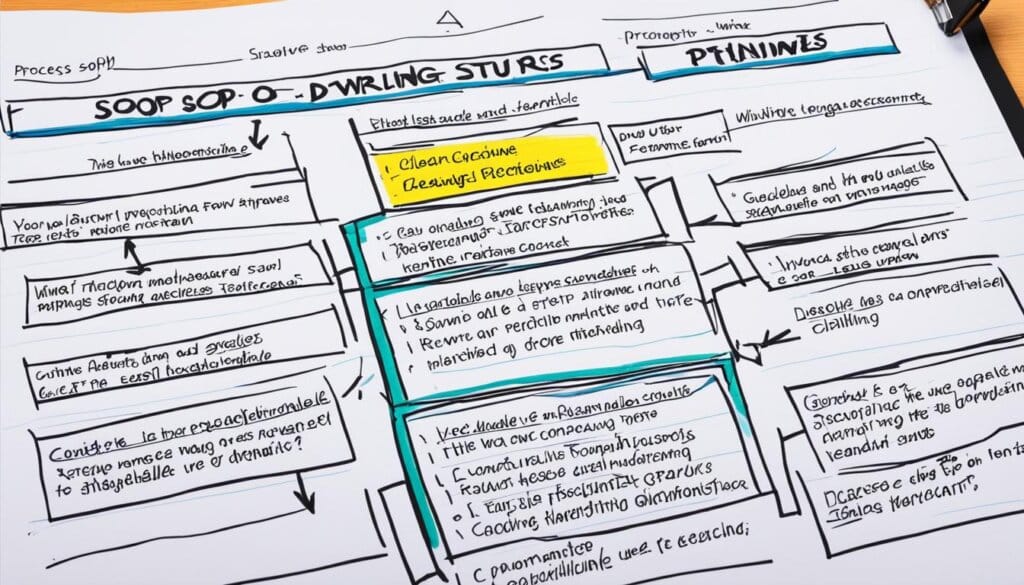Table of Contents
Welcome to our essential guide to Standard Operating Procedures (SOPs). In today’s dynamic business landscape, efficient workflows and adherence to industry standards are crucial for success. That’s where SOPs come in. SOPs, or standard operating procedures, are detailed instructions that guide employees on how to perform specific tasks within an organization.
By implementing SOPs, businesses establish a structured framework that ensures consistency and efficiency in their operations. SOPs streamline workflows, reducing errors and minimizing time wastage. They also uphold product and service quality, making them invaluable for businesses striving for excellence.
Implementing SOPs in your business offers several benefits. They facilitate efficient training of new employees, as they provide a standardized roadmap for success. Additionally, SOPs ensure compliance with industry regulations, minimizing risks and promoting transparency.
In this comprehensive guide, we will dive deeper into the benefits of SOPs, explore the steps to create an effective SOP, discuss best practices for writing SOPs, and examine the crucial role SOPs play in various industries.
Join us on this journey as we unlock the power of SOPs and empower businesses to streamline their processes, maintain industry standards, and achieve greater success.
Benefits of Creating SOPs for a Business
Creating well-structured standard operating procedures (SOPs) offers a multitude of benefits for a business. Let’s explore how SOPs can streamline workflows, reduce errors, maintain quality, provide efficient training, and ensure compliance with regulations.
Streamlining Workflows
SOPs streamline workflows by eliminating redundant steps and time wastage. By clearly outlining the necessary procedures, SOPs help employees understand the most efficient way to complete their tasks and avoid unnecessary delays. This leads to more streamlined operations and improved productivity.
Reducing Errors
With SOPs in place, there is a clear set of instructions for employees to follow, reducing the likelihood of errors. By providing standardized guidelines, SOPs ensure that tasks are performed consistently and accurately, minimizing the risk of mistakes that could negatively impact product or service quality. As a result, businesses can maintain a reputation for delivering reliable and high-quality outcomes.
Maintaining Quality
SOPs are essential for maintaining consistent quality across a business. By providing employees with clear instructions and best practices, SOPs help ensure that processes are carried out in a standardized manner. This consistency in execution contributes to the overall quality of the end product or service delivered to customers.
Efficient Training
When onboarding new employees, SOPs serve as valuable training tools. By providing comprehensive instructions and guidelines, SOPs offer a structured approach to employee training. New hires can familiarize themselves with the proper procedures and expectations, accelerating the learning process and reducing the time required for them to become fully productive contributors to the team.
Compliance with Regulations
In industries with strict regulations, SOPs play a vital role in ensuring compliance. By documenting processes and procedures that align with legal and industry standards, SOPs help businesses meet the necessary requirements. This not only reduces the risk of penalties or legal issues but also promotes transparency and accountability within the organization.
Implementing SOPs provides numerous benefits, including streamlining workflows, reducing errors, maintaining quality, facilitating efficient training, and ensuring compliance with regulations. By harnessing the power of SOPs, businesses can enhance operational efficiency, drive continuous improvement, and achieve sustained success.
Steps to Create an SOP
Creating a standard operating procedure (SOP) involves a systematic process that ensures clarity, consistency, and effectiveness. By following these key steps, you can develop an SOP that enhances operational efficiency and standardizes business practices.
- Identify the process to document: Begin by identifying the specific business process that requires an SOP. This could be a task, a workflow, or a set of procedures.
- Gather information: Collaborate with stakeholders and subject matter experts to collect detailed information about the process. Document step-by-step instructions, decision points, variations, and exceptions.
- Analyze the process: Review the gathered information and analyze the process to identify areas for improvement. Consider factors such as efficiency, accuracy, compliance, and industry standards.
- Develop the SOP: Using an appropriate format and language, create the SOP document. Clearly define the purpose, scope, and responsibilities associated with the process. Include step-by-step instructions, diagrams, or flowcharts, as necessary.
- Review and approve the SOP: Circulate the draft SOP among relevant stakeholders for review. Incorporate their feedback and ensure that the SOP aligns with business objectives and complies with regulations. Obtain final approval from authorized personnel.
- Implement and communicate the SOP: Once approved, communicate the SOP to all relevant personnel. Provide training and support to ensure understanding and compliance. Establish mechanisms for ongoing communication and updates.
By following these steps, you can create an effective SOP that enhances operational efficiency, promotes consistency, and enables continuous improvement.
Writing an Effective SOP
When it comes to writing SOPs, following best practices is key. To create an effective SOP, it is important to keep the end user in mind. SOPs should provide concise and clear instructions in an active voice, ensuring that the intended audience can easily understand and follow them. Ambiguity should be avoided by carefully using important terms such as “may,” “must,” and “should.”
Choosing the appropriate format for an SOP is crucial for its effectiveness. Common formats include checklists, step-by-step lists, hierarchical lists, and process flowcharts. The format should be selected based on the complexity and nature of the process being documented.
The language used in the SOP should be clear and concise, avoiding unnecessary jargon or technical terms. It should be written in a way that is easy to understand, navigate, and follow. The SOP should be structured in a logical manner, with headers, purpose, scope, references, roles and responsibilities, procedure, appendices, revision history, and approval signatures.
“A well-written SOP is one that is concise, easy to understand, and user-focused. It should provide clear instructions for performing specific tasks and enable employees at all levels to effectively carry out their responsibilities.”
Effective SOP Writing Best Practices:
- Write from an end user’s perspective
- Use concise and clear instructions
- Avoid ambiguity
- Choose an appropriate format
- Use an active voice
- Ensure clear and concise language

| Element | Description |
|---|---|
| Header | The title or heading of the SOP |
| Purpose | The reason or objective of the SOP |
| Scope | The boundaries or extent of the procedure |
| References | Any sources or documents that support the SOP |
| Roles and Responsibilities | The individuals or departments involved in the process |
| Procedure | The step-by-step instructions for carrying out the process |
| Appendices | Additional supporting materials or resources |
| Revision History | Record of changes made to the SOP |
| Approval Signatures | Signatures of individuals who have reviewed and approved the SOP |
Importance of SOPs in Various Industries
SOPs, otherwise known as Standard Operating Procedures, play a vital role in multiple industries. They are crucial for improving operations efficiency by providing structure and reducing confusion. By clearly outlining step-by-step instructions, SOPs ensure that employees follow standardized procedures and reduce the risk of errors or inefficiencies.
Another key aspect of SOPs is workplace safety. They act as a comprehensive guide that outlines the necessary safety protocols and precautions to be taken in various tasks. This not only mitigates the risk of accidents and injuries but also creates a secure work environment for employees.
Quality control is another significant area that SOPs address. By ensuring consistent adherence to procedures and regulations, SOPs contribute to maintaining high-quality standards in products and services. This ensures a consistent customer experience and enhances the reputation of the organization.
Moreover, compliance with industry regulations and standards is of utmost importance. SOPs serve as a reliable framework to ensure that companies meet legal requirements and follow best practices. They enable organizations to demonstrate their commitment to compliance and provide a basis for audits and inspections.
Additionally, SOPs also play a crucial role in onboarding processes and training standardization. They provide clear guidance and reference materials for new employees, helping them quickly understand their roles and responsibilities. SOPs also contribute to training standardization by ensuring that all employees, regardless of their location or department, follow the same procedures, reducing variations and ensuring consistency in tasks performed.
FAQ
What are standard operating procedures (SOPs)?
Standard Operating Procedures (SOPs) are detailed step-by-step instructions that guide employees on how to perform specific, repetitive tasks within an organization.
What are the benefits of creating SOPs for a business?
Creating well-structured SOPs offers numerous benefits that positively impact a business’s operations and bottom line. SOPs streamline workflows, reduce errors, maintain product and service quality, facilitate efficient training of new employees, and ensure compliance with regulations.
What are the steps to create an SOP?
To create an SOP, you need to identify the specific business process that needs to be documented, gather information from stakeholders, document the current process, analyze the process for improvement and compliance, develop the SOP using an appropriate format and language, review and gain approval for the SOP, train relevant stakeholders, and establish a plan for ongoing communication and updates.
What are the best practices for writing an effective SOP?
When writing an effective SOP, it is important to follow best practices. SOPs should be written from an end user’s perspective, using concise and clear instructions in an active voice. Choosing an appropriate format for the SOP and including elements like header, purpose, scope, references, roles and responsibilities, procedure, appendices, revision history, and approval signatures is crucial.
Why are SOPs important in various industries?
SOPs are important in various industries for different reasons. They improve operations efficiency, ensure workplace safety, contribute to quality control, maintain compliance with industry standards and regulations, assist in onboarding processes, and help maintain consistency in tasks performed.













